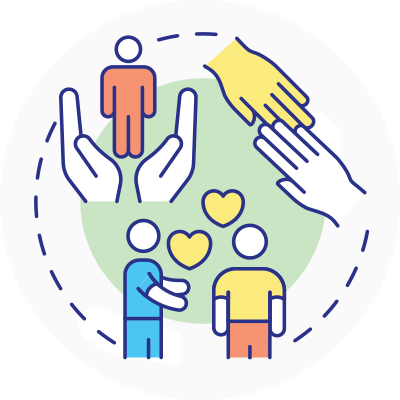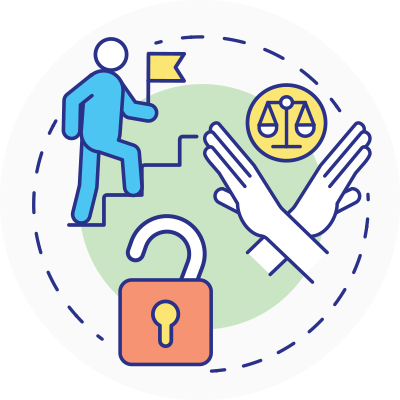Reaching the 95% (R95) Initiative
Background
We are facing the worst overdose crisis in national and local history, and research has shown that two-thirds of people in the United States have been impacted by addiction in some way.While substance use disorder (SUD) treatment has been proven to save lives, only approximately 5% of people with SUDs are accessing treatment services. One of the major reasons why for this small number is because 95% of people with SUDs who don’t access services either don’t want or believe that they need help.
Data demonstrates that unless we prioritize engaging this 95% of individuals with SUDs, it is unlikely that we will increase our treatment access rates. For this reason, substance use systems need to take a fundamentally different approach to better address SUDs by ensuring that programs are designed not just for the 5% of people with SUDs accessing care, but that services are also designed to engage the 95% who are not.
Key Indicators in Los Angeles County
0.0%
Individuals 12+ with Substance Use Disorder (2023)
$0.0B
Alcohol or Other Drug Hospital Spending (2022)0%
Full-Time Employees Use Illicit Drugs (2023)3,000
Alcohol or Other Drug Deaths (2023)*Additional resource - http://publichealth.lacounty.gov/sapc/providers/data-reports-and-briefs.htm
"The opposite of addiction is NOT sobriety;
the opposite of addiction is connection."
Johann Hari, British-Swiss Writer & Journalist
Addiction is often chronic and recurrent, and not all people are at the same stage of readiness to change.
Only focusing on individuals in some stages of change as opposed to ALL stages of change limits service reach and impact.the opposite of addiction is connection."
Johann Hari, British-Swiss Writer & Journalist
The Reaching the 95% (R95) Initiative was launched by the Los Angeles County Department of Public Health’s Bureau of Substance Abuse Prevention and Control (SAPC) in 2023 to focus on increasing the reach of its SUD treatment system and reshaping the way society perceives these conditions.
Purpose and Goals
To ensure that we are designing a specialty SUD system that is focused not just on the ~5% of people with SUDs who are already receiving and open to treatment, but also the ~95% of people with SUDs who do not receive treatment for any reason.To communicate – through words, policies, and actions – that people with SUD are worthy of our time and attention, no matter where they are in their recovery journey or their stage of readiness for change.
To disconnect the concept of readiness for treatment from readiness for abstinence. Requiring abstinence is too high of a bar, and people who are not yet ready for complete abstinence should still be considered for SUD treatment.
Focus Areas
The Reaching the 95% (R95) Initiative allows agencies to grow their clients and services by leveraging payment reform and identifying high impact strategies to ensure that LA County’s SUD system is designed to engage more people with SUDs. There are two Focus Areas under the R95 Initiative that will guide the work of SAPC and its provider network.Enhancing Outreach & Engagement Across the SUD System
Expanding field- and street-based services to provide services for people who are not interested or able to receive services in other settings.
Increasing efforts to interface with other areas of health and social systems to better engage individuals who would benefit from SUD care in those systems.
Expanding low barrier and low judgement services such as harm reduction to better engage people who may not be interested in SUD treatment, but may still be interested in evidence-based services that can improve their health.
Expanding offerings of Medications for Addiction Treatment (MAT) to reduce painful withdrawal symptoms and/or cravings with medications that will improve engagement for individuals interested in this evidence-based treatment option.
Optimizing utilization of a new State policy that allows for outreach services to be reimbursable under Medi-Cal for people with potential substance use conditions.
Increasing efforts to interface with other areas of health and social systems to better engage individuals who would benefit from SUD care in those systems.
Expanding low barrier and low judgement services such as harm reduction to better engage people who may not be interested in SUD treatment, but may still be interested in evidence-based services that can improve their health.
Expanding offerings of Medications for Addiction Treatment (MAT) to reduce painful withdrawal symptoms and/or cravings with medications that will improve engagement for individuals interested in this evidence-based treatment option.
Optimizing utilization of a new State policy that allows for outreach services to be reimbursable under Medi-Cal for people with potential substance use conditions.

Establishing Lower Barrier Care Across the SUD System
Lowering the bar of admissions policies to expand the spectrum of readiness levels of people admitted into SUD treatment.
For example, requiring complete abstinence from drugs to be admitted into SUD treatment is too high of a bar, and lowering that bar will allow for more people to engage with needed services,
similar to how people with diabetes are not required to have a specific blood sugar level before they are considered for diabetes care.
Raising the bar of discharge policies so that there are more nuanced considerations before someone is discharged from treatment as a result of relapse, which is a symptom of addiction.
Strengthening bidirectional referrals between harm reduction and SUD treatment agencies so that individuals with SUDs have access to services that match their readiness and need.
Performing customer experience assessments at the SUD provider level to focus on implementing strategies to make the care environment more inviting, streamline the intake and service delivery process to make it more enjoyable and impactful for participants, and overall improve client engagement.
Raising the bar of discharge policies so that there are more nuanced considerations before someone is discharged from treatment as a result of relapse, which is a symptom of addiction.
Strengthening bidirectional referrals between harm reduction and SUD treatment agencies so that individuals with SUDs have access to services that match their readiness and need.
Performing customer experience assessments at the SUD provider level to focus on implementing strategies to make the care environment more inviting, streamline the intake and service delivery process to make it more enjoyable and impactful for participants, and overall improve client engagement.

Why the R95 Approach Works
The principles behind R95 are evidence-based and supported by rigorous studies of real world patients and treatment and harm reduction agencies. R95 is designed to empower agencies to support their patients through every step of recovery.
- Lapses and relapses are part of the recovery journey. Requiring abstinence can be unnecessarily restrictive and serve more as a barrier than a facilitator to SUD care.
- Lower the bar of admissions and expand the spectrum of readiness levels of people admitted into SUD treatment.
- A patient-centered system meets people with SUD where they are physically or metaphorically and prioritizes efficient admission and processes to promote readiness for services.
- Toxicology tests are clinical tools most effectively used to supplement the patient’s clinical profile, and should not be used as a punishment or trigger for disciplinary action.
- Raise the bar of discharge policies (discharge as a last option) so there are more nuanced considerations before someone is discharged due to relapse, which is a symptom of addiction.
- Bidirectional referrals between harm reduction and treatment agencies provide patients with wrap around support throughout their recovery.
Click for More Details
More additional articles
R95 Guidance and Resources

Program Design and Implementation
Learn More
SAPC is a state leader in launching innovative SUD tools and programs to enhance access to services by individuals who may need treatment, community stakeholders and the SUD workforce.Click the RecoverLA link to learn more about our award-winning mobile-friendly platform that provides SUD service and overdose prevention resources, as well as a filterable service locater.
Click the link to the Service and Bed Availability Tool (SBAT) to locate a treatment provider near you with filters that make searching for specialty SUD services easy: SUDHelpLA.org.
- View the SUD 101 video presentation to learn more about substance use and how to talk to someone with SUD.
- Click the link to the SUD 101 and Accessing Substance Use Treatment in L.A. County Resources to download the SUD 101 presentation slides and substance use treatment in LA County resources guide.



